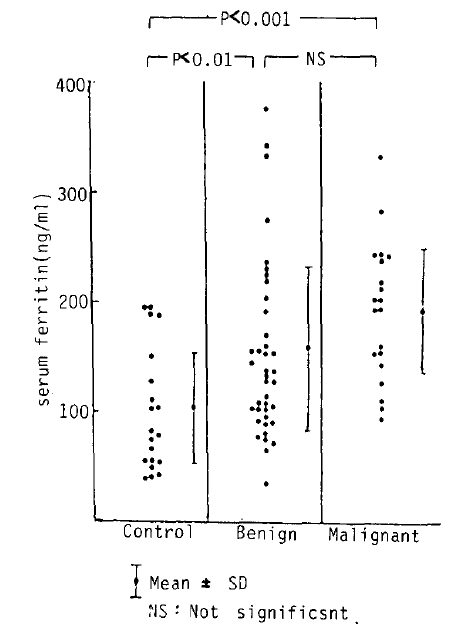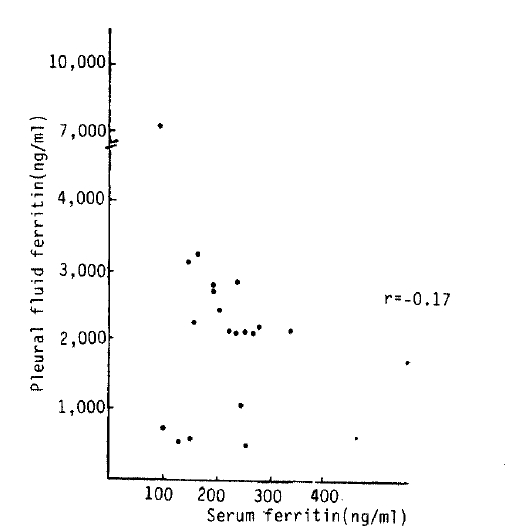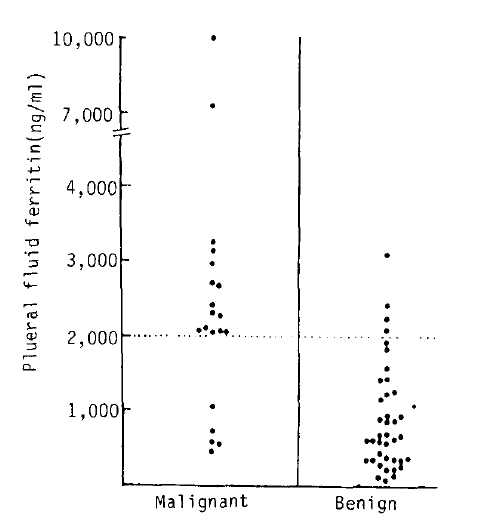1. Jacobs A, Worwood M. Ferritin in serum: clinical and biochemical implications. N Engl J Med 292:951. 1975.


2. Jacobs A, Miller F, Worwood M, Beamish MR, Wardrop CA. Ferritin in the serum of normal subjects and patients with iron deficiency and iron overload. Br med J 28:206. 1972.

3. Jacobs A. Serum ferritin and iron stores. Federation procedings 36:2024. 1977.
4. Lipschitz DA, Cook JD, Finch CA. A clinical evaluation of serum ferritin as an index or iron stores. N Engl J Med 290:1213. 1974.


5. Kim BK, Chang YB, Cho BY, Lee HK, Koh CS, Lee MH. Studies on the serum ferritin assay as an evaluation of storage iron. Kor J Intern Med 24:2. 1982.
6. Rew JS, Kahng HK, Chang KS, Joh NJ, Yoon CH. Studies on the serum ferritin in various malignant tumors. Kor J Intern Med 25:7. 1982.
7. Lee WP, Kim SK, Park SB, Yoon YB, Kim CH, Im JS. Serum ferritin levels in the patients liver diseases. Kor J Gastroenterol 14:1. 1982.
8. Prieto J, Barry M, Sherlock S. Serum ferritin in patients with iron overload acute and chronic liver diseases. Gastroenterology 68:525. 1975.


9. Birgegard G, Hallgren R, Killander A, Stromberg A, Venge P, Wide L. Serum Ferritin during infection: A longitudinal study. Scand J Haematol 21:333. 1978.


10. Marcus DM, Zimberg N. Isolation of ferritin from human mammary and pancreatic carcinomas by means of antibody adsorbents. Ach Biochem Biophysiol 162:493. 1974.

11. Alpert E. Characterization and subunit analysis of ferritin isolated from normal and malignant human liver. Cancer Res 35:1505. 1975.

12. While GP, Worwood M, Parry DH, Jacobs A. Ferritin synthesis in normal and leukemic leukocyte. Nature 250:584. 1974.


14. Salyer WR, Eggleston JC, Ernzan YS. Efficacy of pleural needle biopsy and pleural fluid cytopathology in the diagnosis of malignant neoplasm involving the pleura. Chest 670:536. 1975.

15. Agostoni A, Marasini B. Orosomucoid contents of pleural and peritoneal effusions of various etiologies. Am J Clin pathol 67:146. 1977.


16. Vladutiu AO.
β2-microglobulin in pleural fluids. N Engl J Med 294:903. 1976.

17. Rittgers RA. Carcinoembryonic antigen levels in benign and malignant pleural effusions. Ann Intern Med 88:631. 1978.


18. Jang YS, Jang SH, Sohn HY, Kim SK, Lee WY, Kim KH. A study for carcinoembryonic antigen and ratios of pleural fluid to serum immunoglobulins in pleural effusion. Kor J Intern Med 29:50. 1985.
19. Laufberger V. Sur la cristallisation de la ferritine. Bull Soc Chem Biol 19:1575. 1937.
20. Munro M, Linder H. The function and distribution of ferritin. Physiol Rev 58:317. 1978.


21. Robert R, Crichton B. Ferritin: structure, synthesis and function. N Engl J Med 284:1413. 1971.


22. Puro DG, Richter GW. Ferritin synthesis by free and membrane (poly) ribosome of rat liver. Proc Soc Exp Biol Med 138:399. 1971.


23. Harison PM, Hoarse RJ, Hoy TG. Ferritin and hemosiderin structure and function, Iron in biochemistry and medicine. London: Academic Press, 73. 1974.
24. Lones T, Spencer R, Walsh C. Mechanism and kinetics of iron release from ferritin by dihydroflavins. Am Chem 17:4011. 1978.
25. Linder-Horwitz M, Ruettinger RT, Munro HN. Iron induction of electrophoretically-different ferritins in rat liver, heart, and kidney. Biochem Biophysiol Acta 200:442. 1970.

26. Gabuzda TG, Pearson J, Melvin M. Metabolic and molecular heterogeneity of marrow ferritin. Blood 29:770. 1967.


27. Crichton RR, Miller JA, Cumming RLC. The organ specificity of ferritin in human and horse liver and spleen. Biochem J 131:51. 1974.

28. Massover WH. Multiple isoferritin in mouse liver: Demonstration by polyacrylamide gel electrophoresis. Biochem Biophysiol Acta 532:202. 1978.

29. Drysdale JW, Singer RM. Carcinofetal human isoferritins in placenta and HeLa cells. Cancer Res 34:3353. 1974.
30. Drysdale JW, Adelman TG. Human isoferritin in normal and disease states. Semin Hematol 14:71. 1977.

31. Powell LW, Alpert E, Isselpacher KJ, Drysdale JW. Human isoferritins: Organ specific iron and apoferritin distribution. Br J Hematol 30:47. 1975.

32. Makino Y, Konno K. A comparison of ferritin from normal and tumor bearing animals. J Biochem 65:471. 1969.


33. Alpert E, Coston RL, Drysdale JW. Carcinofetal human liver ferritin. Nature 242:194. 1973.


34. Maxim PE, Prather JR, Veltri RW. Ferritin levels in tissue extracts and serum of patients with carcinoma of the lung. Fed Proc 39:413. 1980.
35. Vincent RG. Biologic markers in lung cancer. Seminars in Res Med 3:184. 1982.

36. Gropp C, Hanemann K. Carcinoembryonic antigen and ferritin in patients with lung cancer before and during therapy. Cancer 42:2802. 1978.


37. Milano C. Use of tumor marker as a supplement to cytology in diagnosis of malignant effusions. Clinical Chemistry 26:1632. 1980.

38. Chung YT, Han YC. Ferritin assay in plerural effusion. Tuberculosis and Respiratory 31:10. 1984.
39. James Mckenna A, Chandrasekhar AJ, Henkin RE. Diagnostic value of carcinoembryonic antigen in exudative pleural effusion. Chest 78:587. 1980.











 PDF Links
PDF Links PubReader
PubReader ePub Link
ePub Link Full text via DOI
Full text via DOI Download Citation
Download Citation Print
Print


